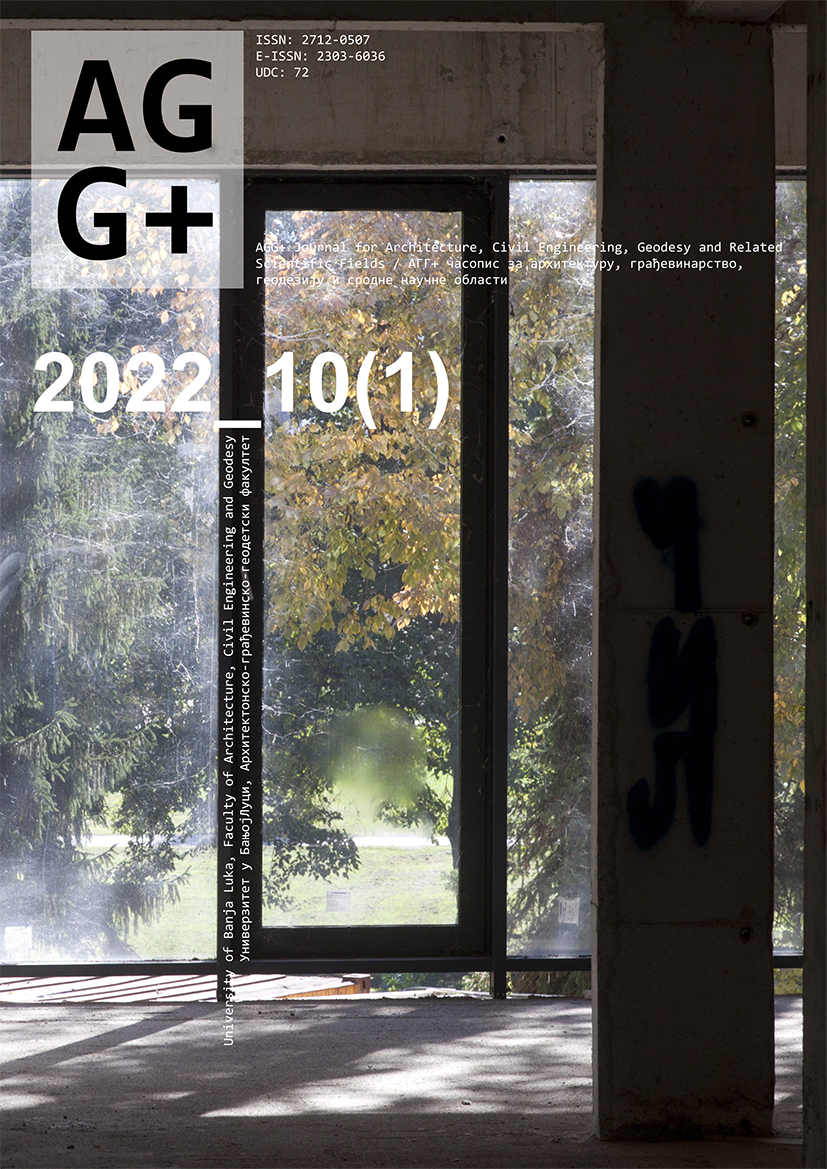Perception of Heritage Values: Experiential Qualitative Model for Assessing the Urban Potential
DOI:
https://doi.org/10.7251/AGGPLUS/2210002SKeywords:
visual impression, identity, globalization, heritage, spatial cognitionAbstract
Modern-day is defined as a period of globalization, a complex construct that can pose a threat to maintaining the uniqueness of a place and creating a distinctive city identity. The hypothesis of this paper is that, while the phenomenon of globalization is researched within different disciplines, a common interdisciplinary theme stands out - the experience and perception of urban space that further builds a unique impression of the observed scene. The assumption will be investigated through the formation of a qualitative model for examining the urban potential with the aim of affirming the visual quality of the place as an important factor in the construction of local identity. The established model is examined through case studies of the 20th-century heritage. This period was chosen because it represents the subject of a contemporary global discussion about the conservation, activation and use of heritage in urban structures. The premise is that the qualitative model can be adequately applied to architecture from this period and contribute to its visibility and understanding, as well as to the examination of its role in the creation of contemporary local identity. The research is significant because it enables an interdisciplinary consideration of heritage as a key factor in building the modern city identity based on its visual impression.
References
M. Castells, “European cities, the informational society, and the global economy“, Tijdschrift voor Economische en Sociale Geografie, vol. 84, pp. 247–257, 1993.
V. Mamadouh, H. Wusten, “Revisiting Castells' Take on the City and the Informational Age“, Tijdschrift voor economische en sociale geografie, vol. 113(3), pp. 230-239, 2022.
A. Gospodini, “Urban morphology and place identity in European cities: built heritage and innovative design“, Journal of Urban design, vol. 9(2), pp. 225-248, 2004.
G. Ashworth, “Heritage and economic development: selling the unsellable“, Heritage & Society, vol. 7(1), pp. 3-17, 2014.
G. Ashworth, B. Graham, J. Tunbridge, “The uses and abuses of heritage“, in Heritage. Museums and Galleries: An Introductory Reader. G. Corsane, ed. London: Routledge, pp. 26-37, 2005.
J. Snowball, “The economic, social and cultural impact of cultural heritage: methods and examples“, in Handbook on the Economics of Cultural Heritage. I. Rizzo & A. Mignosa, ed. Cheltenham: Edward Elgar Publishing, pp. 438 – 455, 2013.
D. McNeill, M. Tewdwr-Jones, “Architecture, banal nationalism and re-territorialization“, International Journal of Urban and Regional Research, vol. 27, pp. 738–743, 2002.
G. Araoz, "Preserving heritage places under a new paradigm", Journal of Cultural Heritage Management and Sustainable Development, Vol. 1(1) pp. 55 – 60, 2011.
S. Bandyopadhyay, G. Garma Montiel. The Territories of Identity: Architecture in the Age of Evolving Globalization. London: Routledge, 2013.
H. Heynen, “Petrifying memories: architecture and the construction of identity“, The Journal of Architecture, vol. 4(4), pp. 369-390, 1999.
D. Papaz, D. Aleksić, T. Vujičić, B. Milojević, "Genius Loci: City place immunity", AGG+ Journal for Architecture, Civil Engineering, Geodesy and other related scientific fields, vol. 7(1), pp. 56-72, 2019.
A. Rapoport, "Environment, Meaning and Communication." in The Meaning of the Built Environment: A Nonverbal Communication Approach. A. Rapoport, ed. Tuscon: The University of Arizona Press, 1990.
M. Vukmirović, "Značaj i uloga mreže pešačkih prostora u generisanju kompetitivnog identiteta grada". PhD thesis, University of Belgrade, Faculty of Architecture, 2013.
T. Ferreira, "Some considerations on the preservation of 20th century architectural heritage". in Modern Building Reuse: Documentation, Maintenance, Recovery and Renewal. V. Riso, ed. Portugal: Universidade do Minho, Escola de Arquitectura, 2014.
S. Marsden, P. Spearritt, THE TWENTIETH-CENTURY HISTORIC THEMATIC FRAMEWORK: A Tool for Assessing Heritage Places. Los Angeles: Getty Conservation Institute, 2021.
T. Trkulja, "Prostor stvaralaštva – između percepcije i doživljaja", AGG+ Journal for Architecture, Civil Engineering, Geodesy and other related scientific fields, vol. 1(1), pp. 84-93, 2013.
H. Sanoff, Visual research methods in design. London: Routledge, 2016.
Institute for the Protection of Cultural Monuments of the City of Belgrade. "Immovable cultural property on the territory of the municipality "NOVI BEOGRAD". Internet: http://18.192.105.101/novi-beograd [10.07.2022].
Do.co.mo.mo. Serbia. "Експериментални блокови 1 и 2 на Новом Београду". Internet: http://www.docomomo-serbia.org/atlas/eksperimentalni-blokovi-1-i-2-na-novom-beogradu/ [11.07.2022].

